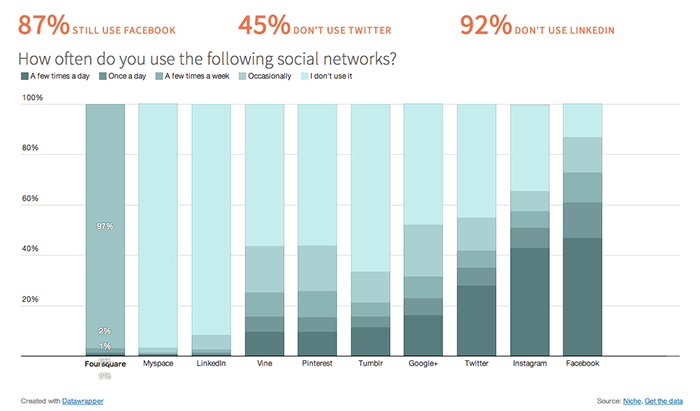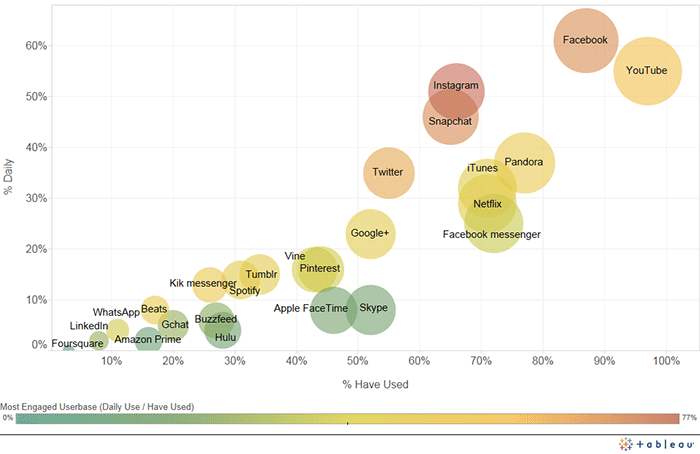We’ve all read the sensational articles about how Facebook is dying out, and isn’t being used anymore by today’s youth, right? Well today, we’re here to see if that’s really true. Niche, a website that collects data from college graduates in the US, compiled very interesting statistics, especially if you know what to look out for.
You might be thinking that in our local market, the media usage of youths varies from that in the US, and you’d probably be right. For example, recent local news about the sharp decline in text messages being sent and received belies the findings by Niche that up to 82% of respondents use text messages daily. While we don’t have those numbers for our local setting (yet), as someone in the same demographic, I can think of very few people who send text messages, and very few instances where I’d think of sending a text message, rather than a Whatsapp message or iMessage, or even use Facebook Messenger.
But one of the biggest lessons we can learn from Niche’s findings is that in spite of all the horror stories about Facebook being on its way out, it’s still the king when it comes to social media usage. 87% of respondents use Facebook – but it’s even more prominent when you compare it to other large social media networks.

Instagram, for example, is used by 66% of teens – still a very good percentage, yet it doesn’t have the same interactivity as Facebook, and doesn’t offer advertising opportunities, yet. Now that it’s owned by Facebook, we’re waiting for promotional opportunities to pop up, or for the newsfeed to be pared down (read our article on why your Facebook reach is declining, to see why this seems likely to appear in Instagram’s future).
Twitter has a teen usage rate of 55%, yet recent redesigns might affect this rate in the future. It seems they’re trying to make Twitter more like Facebook, in spite of their previous attempts to differentiate themselves. With introductions like pre-loaded images in the timeline, and personalisation options to your profile to make it more and more like a personal page, their usage rate may increase among teens – but only time will tell if this is really what today’s youth wants or needs.
Google+, the social network that everyone seemed to think would pose a major threat for Facebook when it was launched, has a low usage rate at 52%, with just 23% of teens saying they use it at least once a day. And we’re taking this usage rate with a pinch of salt anyway – now that everyone with a Google account (think about how everyone nowadays has a Gmail account) automatically has a Google+ page, we’re wondering how many of the respondents actually made their Google+ account intentionally, and use it voluntarily, rather than thanks to Google’s integration policies. While Google+ has definitely built up a good user base, it seems to be more popular with older users.
Apart from Facebook’s popularity, another interesting observation is that social media websites in general have much higher usage rates than any other websites. Even the most popular site amongst teens (Buzzfeed, according to this survey) still lags behind social media websites significantly, with just 27% of respondents saying they’ve used it at least once.

Apart from streaming websites like Pandora, Hulu and Netflix, which aren’t fair to include in this comparison as their usage is for a very different purpose than social media or other sites, all the highest usage rates belong to social media. Let’s take BuzzFeed again – 6% daily usage rate? Ouch. For all the hard work they put into their articles, with user-generated content and so many viral hits, that rate is disappointingly low.
So what can we learn from these statistics? First of all, we now know that Facebook isn’t going anywhere any time soon. And with these numbers giving us a valuable insight into teen internet usage, it’s easier for us to target our advertising to teens in ways that will most likely be more effective.
For example, we can’t deny the effectiveness of Google Ads. Yet if teens are spending most of their time on social media, where Google ads are minimal to none, wouldn’t that be a waste of our money?
It also highlights the importance of having a good, and well-managed, social media presence for any brand that wants to attract young customers. I follow a variety of companies and brands across all the social media I use, and find it worth my time to hit Follow on a clothing brand that uses Instagram well, or a brand that posts handy tips on Facebook. That presence serves as an invaluable tool, especially for top-of-mind recall, and brand equity.
About the Author
This post was contributed by Maya Muscat Azzopardi, a summer intern at Switch. Maya blogs regularly at bluejeansandredlipstick.com.




